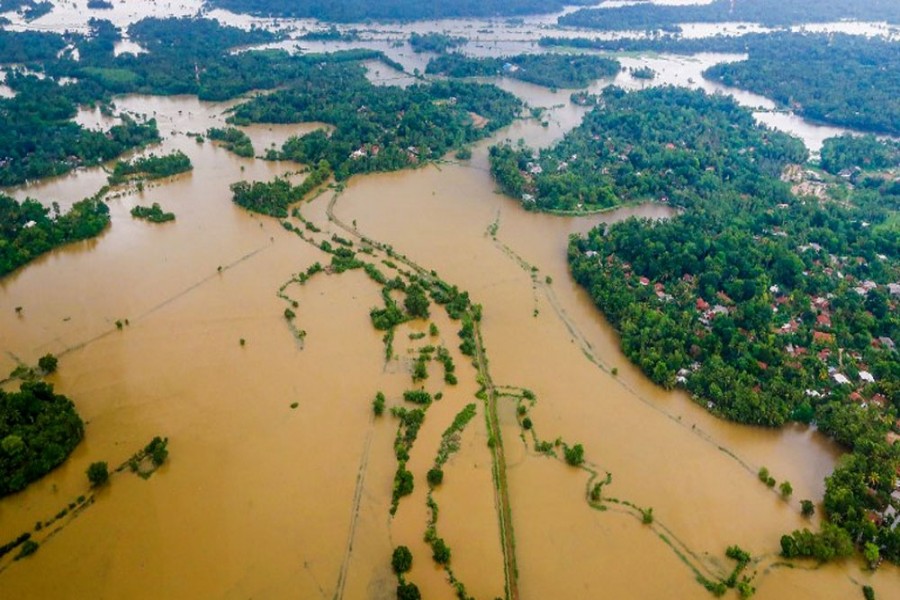
Published :
Updated :

Bangladesh has been subjected to varying degrees of flooding since time immemorial. The people have been living here for generations by cultivating rice and other crops by adjusting with monsoon rainfall and flooding. Traditionally, over 95 per cent people used to be engaged in agriculture and lived in peasant societies practising small-scale subsistence farming with family labour. Life was good for most of them.
However, people living near mighty rivers like the Ganges, the Brahmaputra and the Meghna and their tributaries have been often facing destruction of crops along with demolition of their kutcha and make-shift houses due to river erosion. These people migrated temporarily and, sometimes, permanently to safer places away from the rivers. Floods traditionally brought in many benefits like improved soil fertility, increased capture fishing from widely dispersed floodwater and easy communication with boats.
The conventional reasons for flooding were mainly monsoon climate bringing heavy rain and its associated leaching of snow soils in the Himalayas resulting in heavy runoff in some years. However, with passage of time, the causal factors of flooding have undergone rapid change. Among the present causes of flood, some are man-made like diversion of water for irrigating crops, distraction of water for meeting requirements of urbanisation, use of water for generating power, utilisation of water for purpose of washing, bleaching, colouring, steam generation, cooling agents and so on. Some causes of flood are due to climate factors like heavy melting of glaciers due to increase in global temperature, deforestation in headwater areas causing erratic rainfall.
Floods are also caused by natural reasons like earthquake and landslides, among others. The present-day flooding in Bangladesh has several development implications. In the past, natural factors mainly caused flood; now-a-days, climate change factors, along with man-made factors, have emerged as main causes of the calamity. The net flow of water to Bangladesh is the summation of the effect (Natural factor + Manmade factors + Climate Change Factors).
Under these circumstances, water resource plans for controlling flooding in Bangladesh need to consider a variety of geographic, economic, and environmental factors manifesting upstream as well as within the country. This is a significant challenge, with as high as 93 per cent of the total basin area lying outside Bangladesh. Being the lowermost riparian country, Bangladesh alone cannot undertake any meaningful and comprehensive water development and flood control programmes.
Secondly, over time, the destruction pattern of flood has also changed. Previously in peasant societies, damages were mostly caused to crops, livestock, farming assets and in dwellings. However, now-a-days, due to diversification of the economy as well as economic growth, loss and damage of floods have changed manifold. The loss and damage now range from industries, power generation, urban water supply, road and rail, power and IT infrastructure like optic fibre lines, to name a few.
Thirdly, there is need for a change in focus. Previously, flood control was the main issue. However, now-a-days, there is a need for a wider focus on overall development of the water sector covering agriculture, industry, power, urbanisation, navigation, fisheries, environment and forestry keeping flood control in mind.
The Brahmaputra Basin provides special scope for mutual benefit of the stakeholder countries with respect to energy generation. In the Brahmaputra Basin, China is the most upstream country having hydropower generation potential. India (Arunachal Pradesh) and Bhutan have also hydropower potential, and both these areas have a list of planned hydropower plants. It is known that the total generated capacity would be higher than the anticipated local demand in Bhutan and Arunachal. Although Bhutan and India have signed agreements for distribution of power, Bangladesh is yet to take part in the negotiations. Possibilities for inclusion for Bangladesh exist, as the country is already allowing India for trans-shipment of goods between Assam and Meghalaya and Kolkata port of India.
Fourthly, flood water now flowing to Bangladesh is contaminated by industrial and household sectors both within and outside, which are some of the reasons for environmental degradation in Bangladesh. As Brahmaputra River traverses through China, India and Bhutan before entering Bangladesh, environmental pollution occurring in upstream countries needs to be resolved through discussion with the co-riparian countries. Likewise, salinity intrusion is linked with flow and its velocity which are dependent on upper riparian countries. Salinity intrusion can, therefore, be partly resolved through negotiation for an adequate share of water. These environmental considerations should be very important in Bangladesh. Water-logging in urban and rural areas are caused by several factors, including unplanned and ineffective drainage, encroachment on wetlands in urban and rural areas, and the hampering of tidal flows in the coastal area.
Finally, the present flooding lends support to the urgent need for adopting state-of-the-art 'best management practices' consisting floodplain zoning, planned urbanisation, channelisation, restoration of abundant channels, dredging of rivers and streams, increased elevations of embankments and roads, establishment of buffer zones along rivers and adjustment of citizens' life-style to today's flooding conditions.
Dr Chowdhury Saleh Ahmed is a Faculty Member, Bangladesh Institute of Governance and Management, an affiliated institution of University of Dhaka
salehahmed4081@yahoo.com


 For all latest news, follow The Financial Express Google News channel.
For all latest news, follow The Financial Express Google News channel.